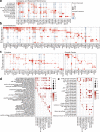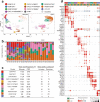An integrated map of fibroblastic populations in human colon mucosa and cancer tissues
- PMID: 36463319
- PMCID: PMC9719516
- DOI: 10.1038/s42003-022-04298-5
An integrated map of fibroblastic populations in human colon mucosa and cancer tissues
Abstract
Fibroblasts and myofibroblasts are major mesenchymal cells in the lamina propria of colon mucosa and in colon cancer tissues. Detailed insight into the highly specific populations of fibroblasts and myofibroblasts is required to understand the integrity and homeostasis of human colon mucosa and colon cancer. Based on gene expression profiles of single cells, we identified fibroblast populations that produce extracellular matrix components, Wnt ligand- and BMP-secreting fibroblasts, chemokine- and chemokine ligand-generating fibroblasts, highly activated fibroblasts, immune-modulating fibroblasts, epithelial cell-modulating myofibroblasts, stimuli-responsive myofibroblasts, proliferating myofibroblasts, fibroblast-like myofibroblasts, matrix producing myofibroblasts, and contractile myofibroblasts in human colon mucosa. In colon cancer tissue, the compositions of fibroblasts and myofibroblasts were highly altered, as were the expressing patterns of genes including BMPs, Wnt ligands, chemokines, chemokine ligands, growth factors and extracellular matrix components in fibroblasts and myofibroblasts. Our work expands the working atlas of fibroblasts and myofibroblasts and provides a framework for interrogating the complexity of stromal cells in human healthy colon mucosa and colon cancer tissues.
© 2022. The Author(s).
Conflict of interest statement
The authors declare no competing interests.
Figures







References
Publication types
MeSH terms
Substances
LinkOut - more resources
Full Text Sources

